This comprehensive guide navigates the diverse feeding habits of these freshwater aquarium snails. While some species thrive on a vegetarian diet, others are carnivorous, and many fall in between as omnivores. Through an exploration of various food options, from vegetables and algae to fruits and commercial foods, aquarists can tailor their snails’ diets for optimal health and shell development.
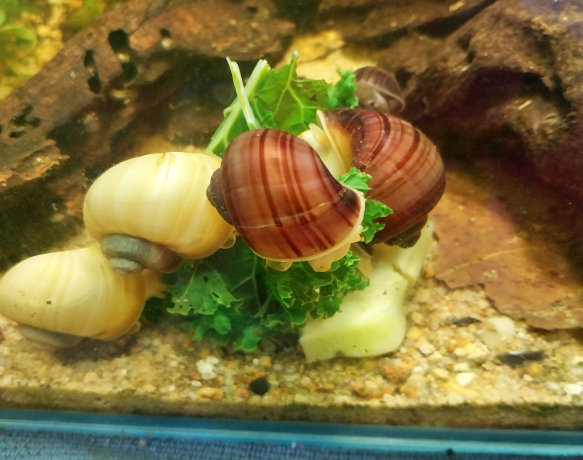
The types of food freshwater aquarium snails can eat, will largely depend on their species. Mystery snails, for instance, are omnivores that require a balanced diet of vegetables and animal protein, while assassin snails are carnivores that feed on the eggs of other snails.
To help you figure out the best dietary regimen for your freshwater aquarium snails, I’ve made a comprehensive guide that covers all of the possible foods they can eat.
See Also: The 14 Popular Freshwater Snail Species for Your Aquarium for a list of pet snail recommendations.
What do freshwater aquarium snails eat?
Aquatic snails can be classified into three categories in terms of their food preferences – herbivores, omnivores, and carnivores.
Most freshwater snails are omnivores that scavenge every possible source of nutrients they find:
Carnivorous snails generally feed on smaller snails and their eggs, or aquatic microworms found in the aquarium. Herbivorous snails go after algae, and plant matter but also enjoy vegetables and fruit. Omnivorous snails eat what most aquarists consider debris in their tanks plus uneaten fish food.
Ideally, all the pet snails in your aquarium should still get food specifically for them to make sure they stay healthy.
You should target-feed them, even if they share their aquarium with fish.
While your snails can eat leftover fish food, this isn’t meant to provide them with a balanced diet.
This is especially true for snail species that are omnivorous or carnivorous.
Aquatic snails also require certain nutrients, such as calcium, to grow healthy protective shells. For this reason, they prefer harder water that is rich in dissolved calcium and magnesium.
If you have soft water, you can add calcium to the aquarium with calcium water supplements, and cuttlebone, or you can feed the snails with calcium-rich vegetables.
Author’s note: The specific nutrients a water snail needs will depend on species and age. For example, baby snails need higher levels of protein as they grow while older snails tend to do better with more fiber.
And, before we move on, let’s quickly address how pest snails survive in an aquarium if they’re not being fed…
Many aquarists, myself included, have tried to rid a fish tank of pest snails, only to find their numbers growing despite best efforts.
These pests survive because snails are opportunistic eaters in general.
They’ll take just about anything they can get.
They may munch on decaying leaves, algae, or any bits of food that sink to the bottom.
Even if you aren’t intentionally feeding them, your aquarium is a living ecosystem and a pest snail will eat whatever it can find.
What’s the best food you can offer to your aquarium snail?

What may work for one species of freshwater snail may not be appropriate for another.
In this section of the guide, I’ll discuss several dietary options, including vegetables, algae, aquatic plants, fruits, and commercial food.
Here’s what freshwater snails can be fed in an aquarium:
Vegetables
Most snails are herbivores or omnivores, and they like to eat a vegetable snack every now and then.
Most veggies are perfectly safe for snails, as long as you’re careful to feed them in ways that don’t impact water quality.
The best way to do this is to provide snails with a snack at the bottom of the tank and remove it later that day so it doesn’t begin to rot in the water.
The best vegetables to feed aquarium snails include snap peas, carrots, lettuce, and leafy greens.
Some snails, like the Mystery snails, also love broccoli.
Tomatoes are generally considered unsafe when given often.
Tomatoes are also particularly watery and lack the calcium snails need, meaning they’re a low-nutrient food. Calcium-rich vegetables, such as leafy greens are an ideal food substitute for when you’re out of dedicated snail food.
It’s likely nothing bad will happen if you feed a tomato to your snail every now and then, but store-bought tomatoes tend to absorb more pesticides than other veggies. Pesticides and dirt can throw off the water parameters in your aquarium and aren’t healthy for the snails.
Author’s note: Before you feed your snail any vegetables, make sure you clean them thoroughly, ideally with dechlorinated water. Dechlorinating the water is important, as tap water can be dangerous for snails and other fish in the tank.
If you’re having trouble keeping veggies on the ground, consider attaching them to a fork.
Stick the fork at the bottom of the tank, or purchase a clip from a pet store to hold the vegetables within your pet’s reach.
Algae
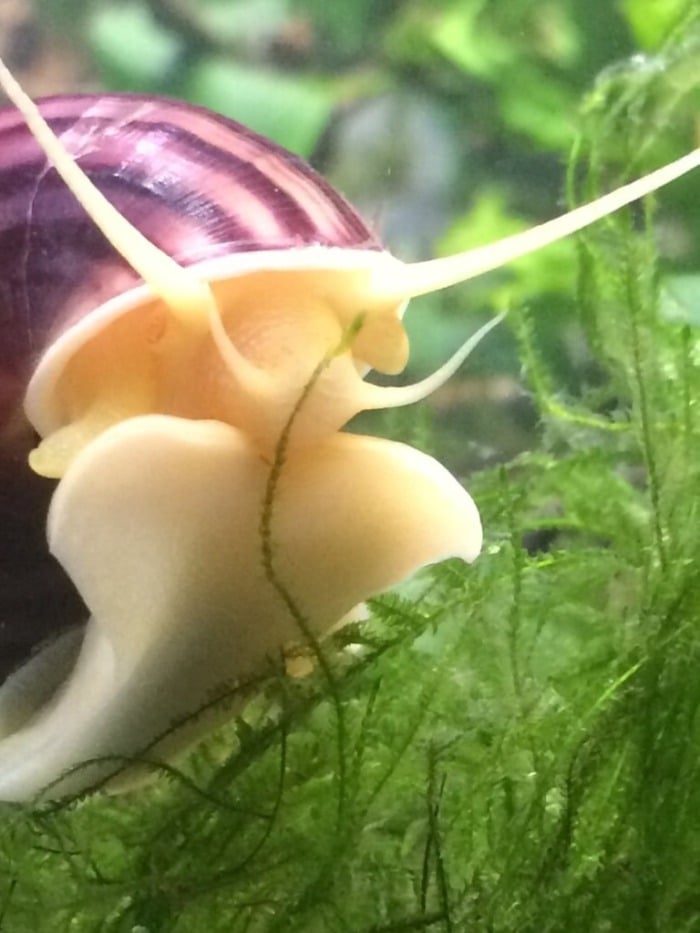
Algae grow in aquariums, even without any fish in the tank.
As tanks are lighted and warmed, algae spread across the tank, coating any surfaces that get enough light.
Most, but not all, freshwater snails will gladly eat algae.
Keep in mind that not all freshwater algae are made equal and some of the types may be ignored.
Green spot algae, for example, is often ignored by snails.
Carnivorous snails also will not eat algae, as it is not an animal product.
The popular Mystery snails enjoy grazing on algae growing on the aquarium’s walls and substrate, but they need more than that to stay healthy.
They are opportunistic scavengers, eating whatever they can find in your aquarium.
Nerite snails, on the other hand, like to eat algae, and even better – they’re not picky.
These voracious snails will eat just about any type of algae, including:
- soft film algae
- soft brown algae
- brown diatoms
Author’s note: Some people claim their Nerites will eat green spot algae, a type that’s notoriously difficult to eradicate, but I haven’t had any luck getting mine to eat it.
Aquatic Plants
Aquatic plants are one of the most important elements of your aquatic ecosystem!
However, if you’re not careful, that beautifully crafted aquascape can quickly become a salad bar.
Most aquarium snails will eat decaying or dead plants, but some will chow down while the plant is still healthy.
You can often discourage munching on healthy plants by keeping your snails fed.
Another trick is to choose species that are less likely to eat the plants in the first place.
If you have a species that does eat aquatic plants, like a large Apple snail or the small Ramshorn snails, you will likely have to replant often.
That’s unless you already have a highly established, heavily planted tank and choose plants with hardier, tougher leaves.
Most snails do not have strong enough jaws to cut through harder leaves.
But wait, aren’t Mystery snails and Apple snails the same thing?!
While Mystery snails are a type of Apple snail, this particular breed often ignores the plants.
If you see them crawling along leaves, they’re most likely just eating the algae off the plants.
One plant-safe type of snail is the Nerite snail.
Nerite snails don’t really like to eat healthy aquatic plants, sticking to algae and dying or already dead leaves.
Fruits

If you have some leftover fruits you need to use up, giving them to your snails is a great way to add some variety to their diet.
Most water snails will happily make quick work of any fruit.
Several fruits are beneficial to snails, but remember to take the same precautions you would with vegetables.
Wash them with dechlorinated water, and if relevant, peel the fruit to make it easier for your snail to reach the good stuff.
Fruits like grapes, melon, apples, and pears work well for snails.
Generally, it’s a good idea to avoid acidic fruits like citrus, as the snail’s skin is too sensitive to tolerate it, and adding acidic fruits to your tank may throw off the pH of the water.
Fruits that are okay to occasionally feed your snail include berries, peaches, and plums.
Avoid feeding your aquarium snails any citrus fruits, pineapple, and avocado, as they aren’t good for them.
Strawberries are acidic and if you choose to feed them to your snails, do so in moderation.
Commercial Foods
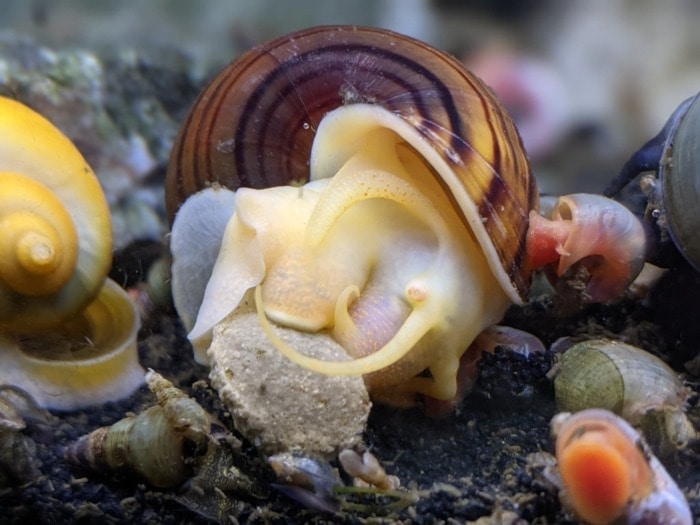
Commercial snail foods are a great one-food option if you don’t want to think about which foods you’re offering. Sinking pellets and wafers to attach to the side of the tank are some of the best ways to feed your snails commercial foods.
Store-bought foods are mixed to provide freshwater snails with everything they need, as long as you choose the right ones.
If you have carnivorous snails, they need food made of animal matter, so make sure you double-check the ingredients before purchasing.
Are aquatic snails reliable algae eaters in a fish tank?
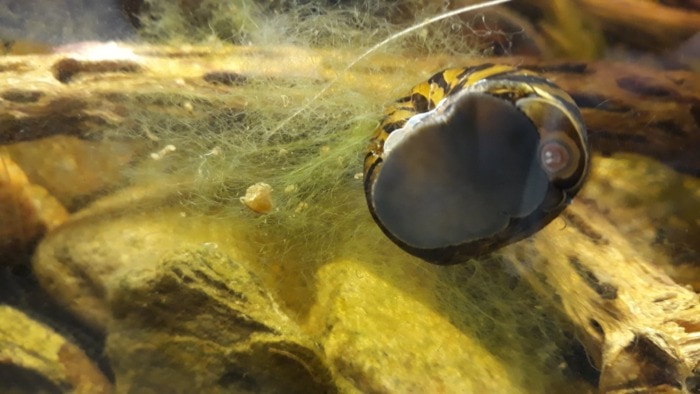
While most aquatic snails will happily devour any algae growing in your aquarium, they aren’t necessarily going to eliminate it.
Snails can’t eat enough to make a serious dent in the algae if there are lighting or water condition issues encouraging the outbreak. However, they will help to keep your tank clean and control overgrowth.
Author’s note: If you have an algae overgrowth problem, it’s better that you figure out the cause and then work to correct the problem than try to rely on snails to control it.
Anyway, there are several snails that are effective at helping tame unwanted algae in aquariums.
Three of my favorites are Nerite snails, Mystery snails, and Ramshorn snails:
- Nerite snails will eat every type of hair algae but they may struggle with green spot algae.
- Ramshorn snails devour most algae and decaying plants.
- Mystery snails are the largest of the three and tend to eat most algae, but have a preference for glass algae, substrate algae, and plant algae.
What’s a good diet example for each of the popular aquarium snails?

Mystery snails are omnivores that do best with diets rich in both algae and animal proteins. To take proper care of your Mystery snails feed them these foods:
- Hair algae
- Brown algae
- Dying or decaying plant matter
- Pumpkin
- Apples
- Pears
- Grapes
- Peas
- Blanched collard greens
- Zucchini
- Leafy lettuce
- Commercial algae wafers
Nerite snails are technically omnivorous but about 90% of their diet is usually plant matter of some sort. They will eat just about any debris that go into your tank if there are no other food sources available.

The best things to feed your nerite snails are:
- All types of algae, though green spot algae may be difficult for them
- Dying or decaying plant matter
- Bananas
- Cherries
- Watermelon
- Cucumber
- Broccoli
- Green beans
- Blanched kale
- Blanched spinach
- Zucchini
- Bloodworms
- Commercial algae wafers
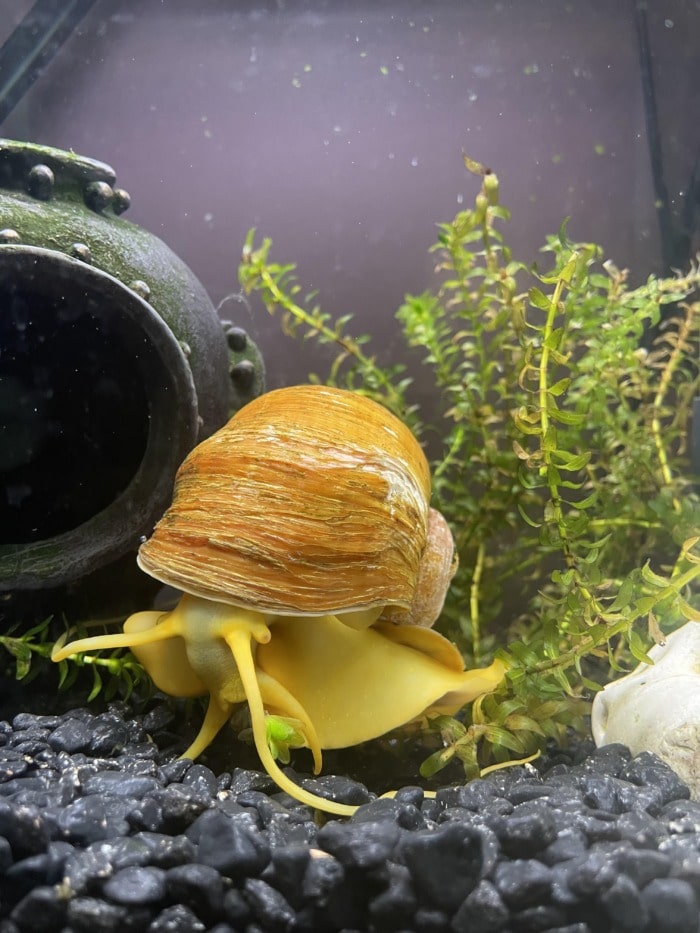
Apple snails are omnivores, though they enjoy high levels of vegetation in their diets. They will thrive with foods such as:
- Bottle brush algae
- Hair algae
- Dying or decaying plant matter but also healthy aquatic plants
- Melon
- Cucumber
- Lettuce and leafy greens
- Blanched carrots
- Green beans
- Turnips
- Brine shrimp
- Commercial algae wafers
Ramshorns are omnivorous and will eat whatever they can find in the tank. Consider these options:

- Hair algae
- Soft green algae
- Most other algae other than green spot
- Dying or decaying plant matter
- Banana
- Watermelon
- Cucumber
- Lettuce
- Zucchini
- Seaweed
- Spinach
- Cauliflower
- Bell pepper
- Commercial snail food, like algae wafers
- Pleco wafers (make sure they don’t have copper!)
Unlike the other options discussed, Assassin snails are carnivorous. They tend to bury themselves in substrate before attacking invertebrates that pass them by.
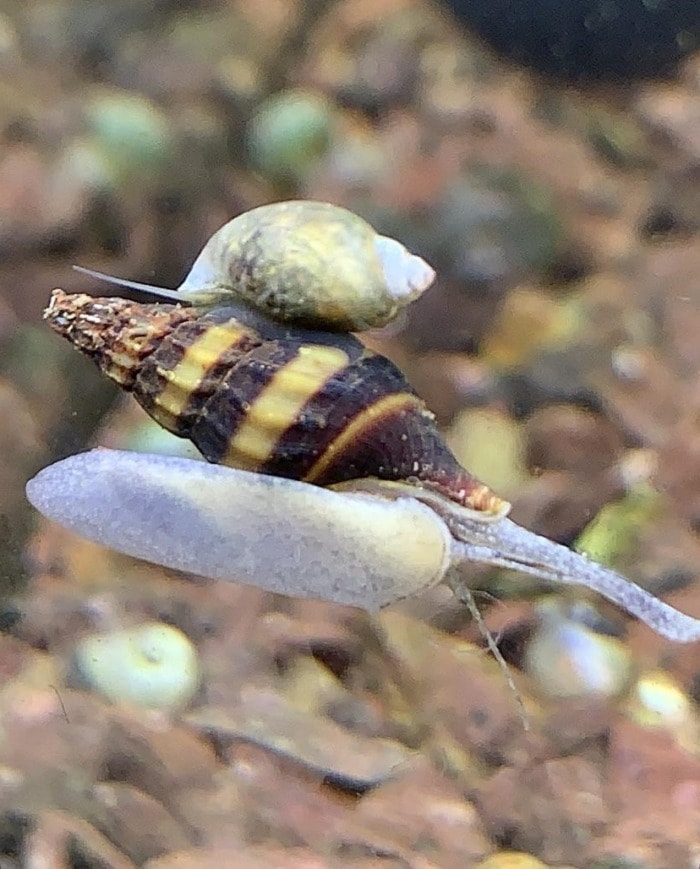
They’re a popular option to handle unwanted snail infestations since they’ll happily snack on them.
But, they can also be pests in their own right.
If you decide to keep these snails, they do best with foods such as:
- Commercial food for carnivorous invertebrates (choose sinking pellets or wafers)
- Live snails
- Bloodworms
- Brine shrimp
- Mysis shrimp
- Frozen mussel
What to feed baby snails?
Baby snails will eat the same foods as adults of the same species.
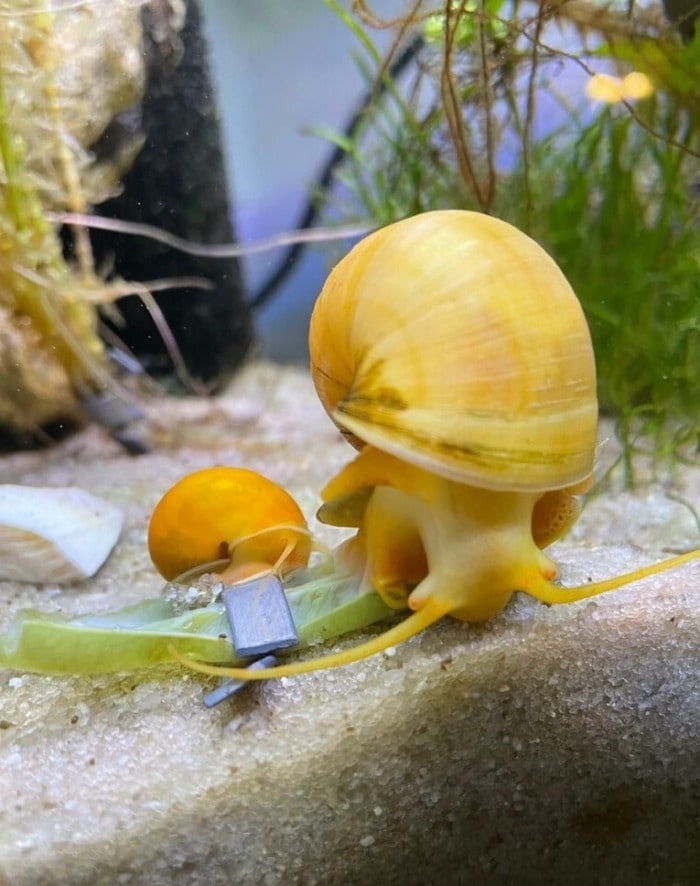
However, they do need lots of calcium added to their diet and environment.
They also need protein available to help them grow healthily.
Like adults, baby snails tend to eat algae, rotting plants, leftover fish food, phytoplankton, and anything else they can find within their reach.
If they don’t have access to enough food and the correct nutrients, they may not grow well.
Author’s note: Mystery snails often surprise their new owners with a clutch of unexpected eggs. For this reason, I will address their babies in particular:
You can feed your baby Mystery snails just about anything you’d feed to an adult.
Provide them with plenty of calcium-rich vegetables and some shrimp pellets or what’s known as Snail Lello -, a mixture of gelatin, calcium-rich baby food, blood worms, and fish food.
Just remember that baby Mystery snails won’t eat nearly as much as their parents, so plan accordingly!
My Final Thoughts
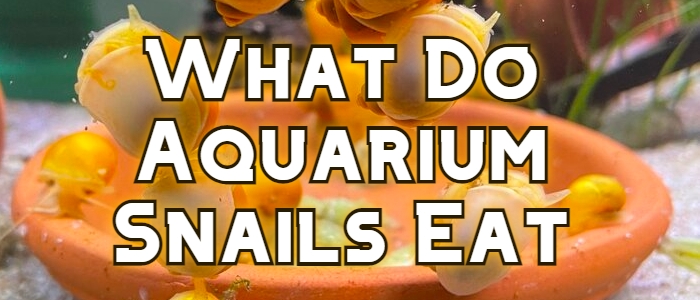
Snails make great aquarium additions, whether in a tank all on their own or kept with fish.
They’re also not particularly picky eaters.
As long as you keep up with feeding them foods rich in protein and calcium, they should thrive in just about any setting.
Just remember to always double-check your specific species before choosing out food.
Also, don’t let any food remain in the water for longer than 24 hours before removing it to keep your snails and their environment healthy.


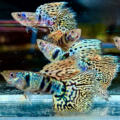

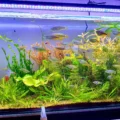
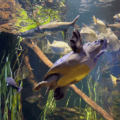

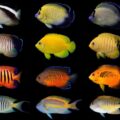
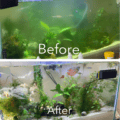
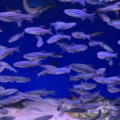
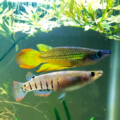
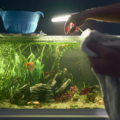
6 thoughts on “What Do Freshwater Aquarium Snails Eat? (+Tips)”